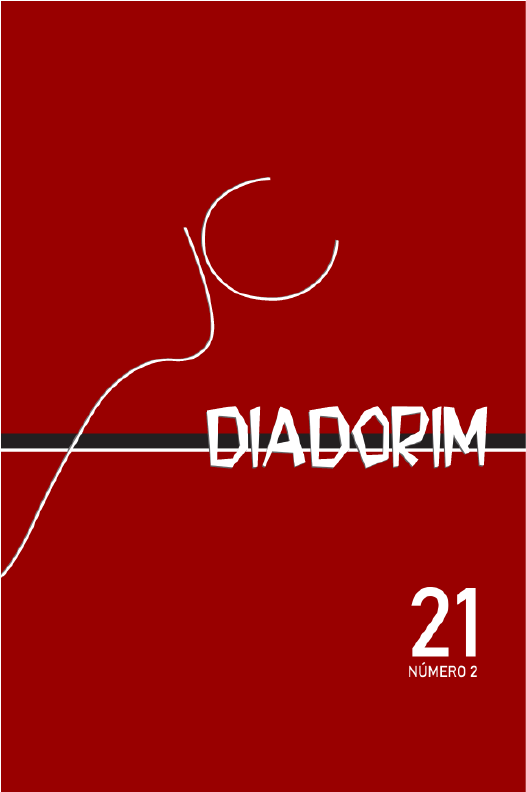UM ESTUDO DA VARIAÇÃO LINGUÍSTICA NO LIAME PREPOSICIONAL EM CONSTRUÇÕES [VDAR + PREPOSIÇÃO + VINFINITIVO] NO PORTUGUÊS DO BRASIL
DOI:
https://doi.org/10.35520/diadorim.2019.v21n2a25513Keywords:
Gramática de Construções, variação linguística, verbo DAR, preposição.Abstract
Tendo como sintaxe de busca a estrutura VDAR + PREPOSIÇÃO + VINFINITIVO esta pesquisa analisou 1.141 ocorrências do verbo DAR, na língua portuguesa, coletadas no sítio Corpus do Português, do século XVIII ao século XIX. De posse desses dados, dedicamo-nos a categorizar as construções e a investigar em que medida elas apresentam diferenças substanciais, já que nos pareciam formalmente idênticas. Buscamos ainda identificar suas principais funções linguísticas, bem como explorar possíveis contextos de variação entre elas. Para alcançar tais objetivos, apoiamo-nos teoricamente no modelo da Gramática de Construções, mais especificamente no Princípio da Não-Sinonímia (cf. BOLINGER 1968; HAIMAN 1985; CLARK 1989; GOLDBERG, 1995), e adotamos uma metodologia de interface entre a gramaticalização de construções e a sociolinguística laboviana (NEVALAINEN e PALANDER, 2012; POPLACK 2012). Nossos resultados evidenciam quatro tipos de construções com o verbo DAR: (i) mesoconstruções, (ii) construções de estrutura cristalizada, (iii) construções aspectuais e (iv) construções modais. Além disso, acusaram um contexto de variação possível apenas nas construções aspectuais.
References
ANDERSON, G. D. S. Auxiliary verb constructions. New York: Oxford University Press, 2006.
BAILEY, G. Real and apparent time. In: CHAMBERS, J. K.; TRUDGILL, P.; SCHILLING-ESTES, N. The handbook of language variation and change. Oxford: Blackwell, 2002.
BARROSO, H. O aspecto verbal perifrástico em português contemporâneo: visão funcional/sincrónica. Porto: Porto Editora, 1994.
BECHARA, E. Moderna gramática portuguesa. 37ª ed. Rio de Janeiro: Nova Fronteira, 2009.
BOLINGER, D. Entailment and the meaning of structures. Glossa, 2, 1968. p.119-127.
CASTILHO, A. de. Introdução ao estudo do aspecto verbal na língua portuguesa. Marília, Faculdade de Filosofia, Ciências e Letras, 1968. (Coleção de Teses, 6).
CLARK, E. V. The Principle of Constrast: A Constraint on Language Acquisition. In B. MacWhinney (ed) Mechanisms of Language Acquisition. Hillsdale, NJ: Lawrence Erlbaum Associates. 1987.
COMRIE, B. Aspect: A introduction to the study of verbal aspect and related problems. New York: Cambridge University Press, 2001 [1976].
COSTA, S. B. B. O aspecto em português. São Paulo: Contexto, 1990.
DAVIES, M.; FERREIRA, M. J. Corpus do Português: 45 milhões de palavras, 1300s a 1900s. 2006. Disponível em: <http://www.corpusdoportugues.org/x.asp> Acesso em: 23 jan. 2016.
DUBOIS, J. et alli. Dicionário de linguística. 16ª ed. São Paulo: Cultrix, 2011. 653 p. (Publicado originalmente em francês, sob o título Dictionnaire de linguistique. Paris: Larousse, 1973), [trad. Frederico Pessoa de Barros, Gesuína Domenica Ferretti, John Robert Schmitz, Leonor Scliar Cabral, Maria Elisabeth Leuba Salum, Valter Kehdi.].
FISCHER, O. Grammaticalization as analogically drive change? Vienna English Working Papers, v. 18, n.2, 2009, p. 3- 23.
GOLDBERG, A. Constructions: a construction grammar approach to argument structure. Chicago: The University of Chicago Press, 1995.
_______. Constructions at Work: the nature of generalization in language. Oxford: Oxford University Press, 2006.
HAIMAN, J. Natural syntax: iconicity and erosion. Cambridge: Cambridge University Press, 1985.
LABOV, W. Padrões Sociolinguísticos (Trad. Marcos Bagno, Maria Marta Pereira Scherre, Caroline Rodrigues Cardoso). São Paulo: Parábola Editorial, 2008 [1972].
MacWhinney, B. Competition and Lexical Categorization. In Current Issues in Linguístic Theory 61: Linguistic Categorization. Amsterdam: John Benjamins. 1989.
MAURER JUNIOR, T. H. Gramática do latim vulgar. 3. ed. Rio de Janeiro: Livraria Acadêmica, 1959.
NEVALAINEN,T.; PALANDER-COLLIN, M. Grammaticalization and sociolinguistics. In: NARROG, H.; HEINE, B. (eds.). The Oxford handbook of grammaticalization. Oxford: Oxford University Press, 2012. p. 1-8, Online.
POPLACK, S. Grammaticalization and linguistic variation. In: HEYNE, B.; NARROG, H. Handbook of grammaticalization. Oxford: Oxford University Press, 2012. p. 209-224.
SAID ALI, M. Gramática histórica da Língua Portuguesa. São Paulo: Melhoramentos, 1966.
SAID ALI, M. 2001 [1921]. Gramática histórica da língua portuguesa. 8. ed. rev.e atual. por Mario Eduardo Viaro. São Paulo: Companhia Melhoramentos: Brasília, DF: Editora Universidade de Brasília.
SILVA, S. E. P. A construção verbal V1 DAR + PREPOSIÇÃO + V2 INFINITIVO: um estudo na interface Sociolinguística e Gramaticalização. Dissertação (Mestrado em Estudos Linguísticos) – Faculdade de Letras, Universidade Federal de Minas Gerais. Belo Horizonte, p. 98. 2018.
TARALLO, F. A pesquisa sociolinguística. São Paulo, Ática, 1985.
TRAUGOTT, E; TROUSDALE, G. Constructionalization and constructional changes. Oxford, Oxford University Press, 2013.
TRAVAGLIA, L. C. O aspecto verbal no português: a categoria e sua expressão. 5.ed. Uberlândia: EDUFU, 2016 [1981]. 316 p.
Downloads
Additional Files
- QUADRO 1 - Verbo DAR em contexto de finalidade com preposição “de” (Português (Brasil))
- TABELA 1 - Análise da frequência diacrônica dos types preposicionais da categoria aspectual (Português (Brasil))
- QUADRO 2– Comparativo entre os usos do verbo DAR na estrutura [V_DAR+ preposição+ V_INFINITIVO] (Português (Brasil))
Published
Issue
Section
License
Copyright transfer -- Authorization to publication
If the submitted article is approved for publication, it is already agreed that the author authorizes UFRJ to reproduce it and publish it in Diadorim: revista de estudos linguísticos e literários, the terms "reproduction" and "publication" being understood as defined respectively by items VI and I of article 5 of Law 9610/98. The article can be accessed both by the World Wide Web (WWW) and by the printed version, with free consultation and reproduction of a copy of the article for the own use of those who consult. This authorization of publication is not limited in time, and UFRJ is responsible for maintaining the identification of the author of the article.

The journal Diadorim: revista de estudos linguísticos e literários is licensed under a Creative Commons Attribuition-NonCommercial 4.0 International (CC BY-NC 4.0).

